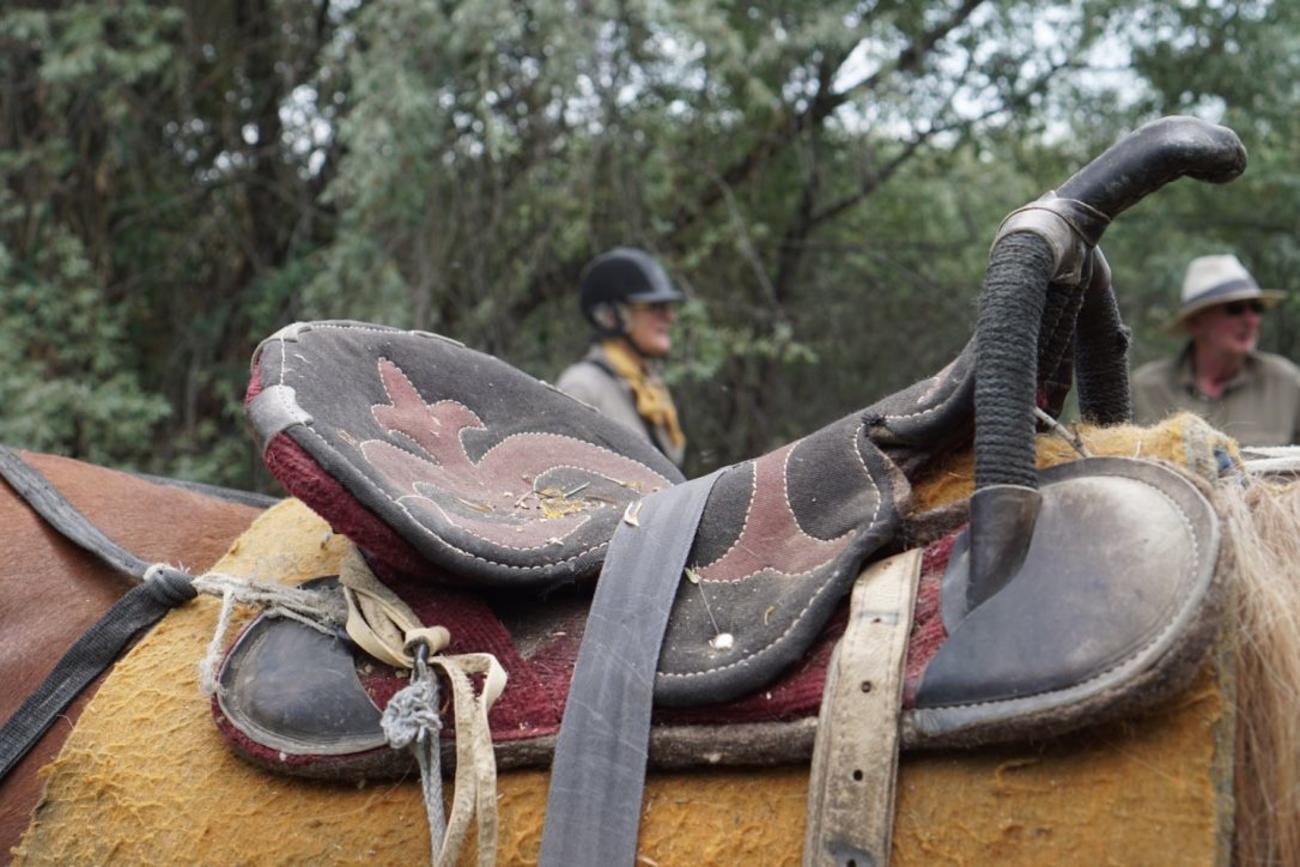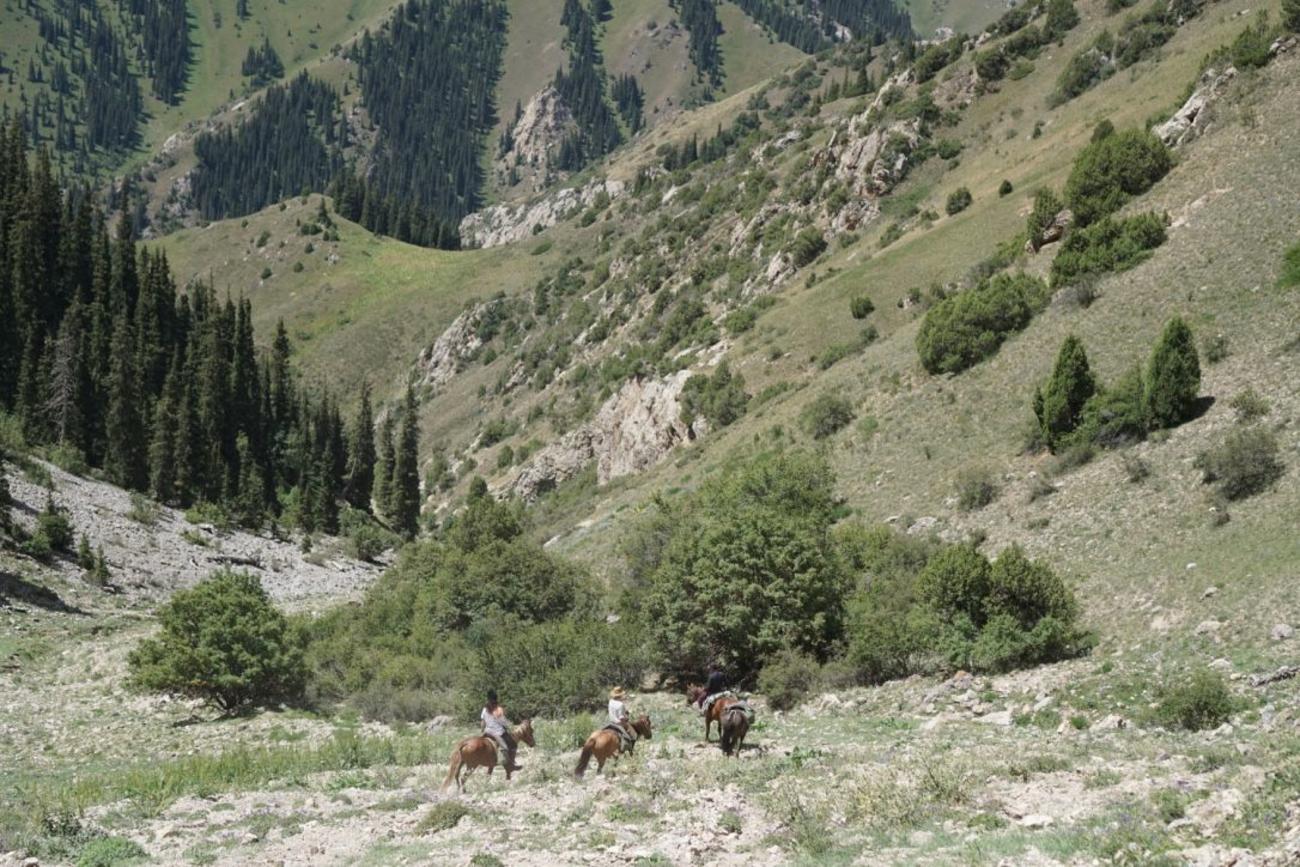Continuing our journey towards the mountains and our horses for the next ten days, we stop at a village called Kochkor to visit a felt-making workshop. We are given a demonstration by some lovely women from this women’s cooperative into the art of Kyrgyz felt making. The project helps provide an income for over one hundred women. They kindly let us try the first process of felt making by pulling apart the wool and placing it on their template. The next stage was very interesting and tiring work. They roll the felt up in a type of dry grass that looks like bamboo and pour boiling water over it twice to bind the unwashed wool together. They then stamp it whilst rolling it for a prescribed amount of time depending on the size of the felt craftsmanship. This was great fun as we all attempted to coordinate our stomping and singing and not tripping up on the felt with these talented Kyrgyz women. For our creation, the stamping took fifteen minutes and it was then unrolled, washed and hung up to dry.


'Ddddd' the minibus goes as we slowly make our bumpy way along the dirt road to our yurt camp in Son Kol, a 3000m high glacier lake which is home to 190 species of birds. Along our drive, we spot a young boy riding a donkey dragging a wrapped felt creation. He tells us he must do this for the next hour, an easier method we feel than our previous day's attempt. Arriving to our nomadic family who caters to tourists, we are excited about our first night in a yurt and about meeting our horses. The centre of a yurt is depicted in the image of the Kyrgyzstan flag, representing the 40 nomadic tribes that were united against the Mongols by the hero Manas. It is made up of a wooden circular frame, covered with felt and braided with ropes. The men make the wooden frames, leather and metal details. Whilst the women make the interior decorations and exterior coverings. The record in putting up a yurt was nine minutes in the 2018 world nomadic games that took place on the shore of Issy Kul.

Adjusting to the different tack the Kyrgyz people use which is very comfortable owing to the padding they place over the saddle, we set off to explore a bit of Son Kol, a popular trekking area. Marvelling at the wildflowers that we see dotted around the landscape as we climb up to a viewpoint. There are approximately 4,000 different varieties of flora in Kyrgyzstan. This great biodiversity owing to its varied landscapes and altitude. On the alpine meadows (about 3000 m above sea level) grow edelweiss, dandelion, alpine aster, Semenov onion, primroses and many more.


Riding over towards us we meet a young teenage shepherd who has come to the lowlands with his parents for the summer pastures to tend to a flock of 500 plus sheep and goats. A lamb has been born the night before and is riding shotgun on the shepherd’s saddle. After some pleasantries, we continue our journey passing more families along our route. The children regularly pop their heads out of their yurts to say hello in English, waving and smiling. "Chuy, Chuy," we say to our horses, prompting them to quicken their pace, enjoying our first canter as we travel along a narrow switchback to our viewpoint at the top of the mountain overlooking the lake.

The next day we set off for the Kurtka river and our first night wild camping. We undertake our first long descent of 1200m from an elevation of 3030m through craggy outcrops and alpine forests, stopping to take pictures of the various wildflowers we encounter along the way and to take in the ever-increasing scale of the mountain scenery we pass through. We stop at a yurt camp for lunch by a gently meandering river that is a welcome respite from the strong midday sun. Placing our feet in the cold water and splashing our faces, a family who arrived from Northern Kyrgyzstan to visit their relatives the day before taking the opportunity to practise their English with us. One of them, a young mother, disappears from the group and reappears carrying a jug. In it is Jarma, a popular barley drink often sold along the side of the road in Bishkek during the summer months. Thanking her, I have a taste. It has a pleasant aroma and tastes refreshing, just what is needed before our final ride to camp.

Arriving at our wild camping spot we get in for a quick paddle to clean ourselves after the days ride. There's just about enough water to submerge ourselves if we sit on the riverbed. It is fresh but manageable and a welcome relief for all who brave it. The horses are hobbled for the night and between their whinnies and the murmuring river I am lulled to sleep.
